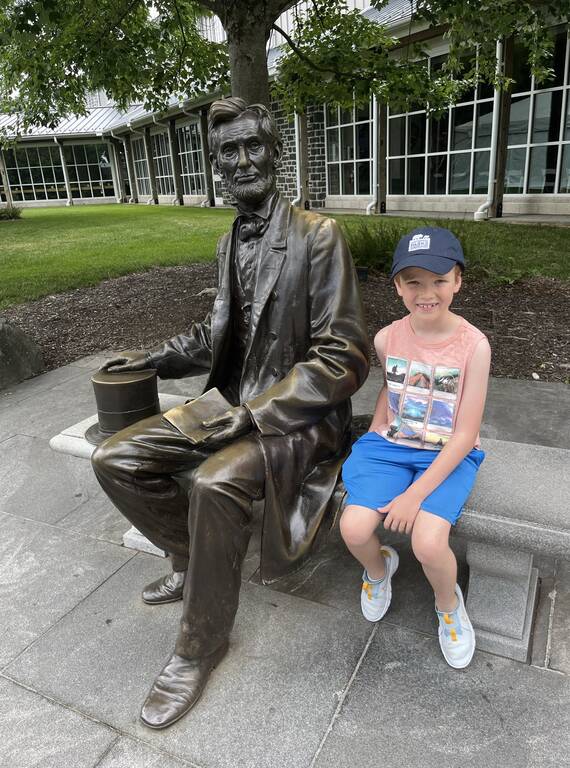Marking the 160th anniversary of the Civil War’s bloodiest battle, Gettysburg National Military Park has expanded its historical interpretation. Visitors now can learn more about the history of free and enslaved Blacks and the context of Confederate monuments.
Millions of people visit Gettysburg National Military Park, our nation’s Civil War “living classroom,” each year — from school groups and vacationing families to aspiring military leaders at the nearby Army War College studying leadership and strategy. What always amazes me about this place, even 160 years following the Battle of Gettysburg in July 1863, is there is still such a strong fascination with what occurred leading up to, during and following those three pivotal days. I completely get it.
When I first visited as an 8-year-old, Gettysburg sparked my lifelong fascination with Civil War history because the meticulously preserved space was truly transforming. When you stand on the battlefield, you can’t help but imagine the sights, sounds and smells experienced during a horrific chapter in our nation’s history and reflect on all that hung in the balance on that rural landscape — from the preservation of the United States to the abolition of slavery and the immense number of Americans who committed the ultimate sacrifice that day.
I’m so proud of the campaigns we’ve led at NPCA to protect this place throughout our organization’s history to ensure that Gettysburg still has a preserved landscape. During the 150th anniversary in 2013, I spent the majority of my time there mobilizing visitors in opposition to a proposed casino adjacent to the battlefield. Thankfully, we were successful.
At yet another milestone anniversary earlier this month, I was thankful for the recent efforts underway to provide important context to visitors exploring the more than 1,200 monuments and markers — dramatic depictions carved from granite and bronze that commemorate and memorialize those who fought and died at Gettysburg.
The meaning of Confederate monuments
Following the murder of George Floyd in May 2020, Americans began to more deeply scrutinize Confederate monuments in public spaces, many of which were removed as our nation grappled with its history of racial violence. Removing Confederate monuments from urban centers and community parks became part of larger efforts to address racial injustice.
Likewise, the future of Confederate monuments at places such as Gettysburg National Military Park was also being considered. NPCA supported efforts by the National Park Service and historians to inventory all the commemorative works on Civil War battlefields — many of which were added in the 20th century by the United Daughters of the Confederacy during the height of Jim Crow segregation to memorialize Confederate sympathy and the “Lost Cause.” At Gettysburg alone, 11 Southern states’ memorials were added between 1917 and 1984.
Today, Gettysburg better reflects the historical context of these Confederate monuments through new interpretative markers placed beside them.
NPCA supported efforts by the National Park Service and historians to inventory all the commemorative works on Civil War battlefields — many of which were added in the 20th century … during the height of Jim Crow segregation.
Informed by historians, these markers share the history of the monuments’ sponsorship and dedication. They also address that while memorials were installed to recognize courage and bravery, they also ignored the causes of the war, especially slavery.
Historian and educator Kevin Levin views this as an important moment for “parks to use Confederate monuments on the battlefield to tell stories that haven’t been discussed.”
More diverse perspectives
At the nearby Warfield House, a new interpretative panel tells the story of African Americans’ displacement in Pennsylvania in response to the invading Confederate Army. Hundreds of free Black families, including James and Eliza Warfield, were forced to flee and abandon their homes in fear of being kidnapped and forced south into slavery.
According to Gettysburg Chief of Interpretation and Education Christopher Gwinn, these changes are “part of an interpretative shift that has been underway for 30 years — to place the Battle of Gettysburg within the larger context of the American Civil War, including addressing its causes and consequences.” Gwinn said he has immense pride for being part of this “interpretative transformation.”
During the 160th anniversary activities July 1-3, programming that historically focused on decisive moments of the battle and its military leaders expanded to include more diverse perspectives. Dr. Peter S. Carmichael of Gettysburg College’s Civil War Institute partnered with the Park Service to organize “Enslaved at Gettysburg,” a tour for visitors where they heard the experiences of thousands of enslaved men who accompanied Confederates into Pennsylvania. Visitors also were introduced to a range of published letters and diaries related to African American experiences.
According to Carmichael, these programs were designed to “use the battlefield to open up our eyes to its relationship to those who were not soldiers, but present — women, children, African Americans.
“Standing in front of the Virginia Monument to give a talk about enslavement within Robert E. Lee’s army was powerful. Stories must be told on that ground that are not only through the perspective of Confederate military leaders,” he said.
A new generation’s understanding

The author’s child with a sculpture depicting President Abraham Lincoln on the day of his Gettysburg address, which he delivered for the dedication of the Soldiers National Cemetery in November 1863.
Courtesy of Ed StierliI’ve visited Gettysburg countless times, but this trip was special because I brought my almost 8-year-old child to experience the history and significance of this place as I did at that age.
A battlefield that once memorialized Robert E. Lee and the “Lost Cause” now made it clear that slavery was a root cause of the Civil War, and the emancipation of millions of enslaved people was at stake.
The interpretation that my child read and experienced, the tours that he joined, and the conversations he and I had about the horrors of slavery and war and the families caught in the crossfire were much different — because of the park’s commitment to telling the complete story.
Stay On Top of News
Our email newsletter shares the latest on parks.
About the author
-
 Edward Stierli Senior Regional Director, Mid-Atlantic
Edward Stierli Senior Regional Director, Mid-AtlanticEd serves as Senior Director in the Mid-Atlantic region, overseeing NPCA’s activities in five states and the District of Columbia.


